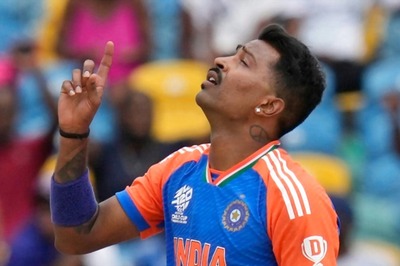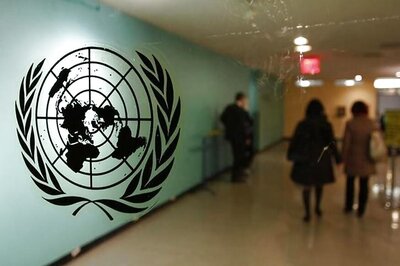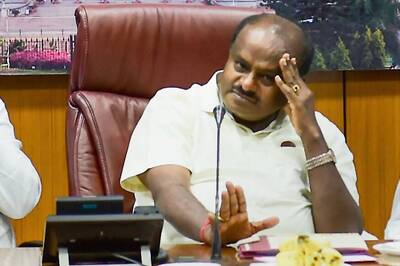
views
A three-judge bench of Supreme Court headed by Justice D.Y. Chandrachud on Friday shifted the Gyanvapi Masjid trial suit proceedings from civil judge (senior division) to district judge. It also directed the district judge to decide on the priority of the pleadings under Order VII Rule 11 of the Code of Civil Procedure challenging maintainability of the suit by five Hindu women seeking to worship Goddess Shringar Gauri and other deities inside the Gyanvapi complex. It said that ascertaining the religious character of the place will not fall foul of the Places of Worship (Special Provisions) Act, 1991. The Bench orally observed, “Putting a cross on Zoroastrian Religious Place would not change the latter’s character. This is true for the reverse case scenario.”
Meanwhile, an appeal has been filed in a Delhi court regarding the restoration of 27 Hindu and Jain temples in the Qutub Minar complex in Mehrauli. In Mathura, the district court has ruled that the civil court’s refusal to admit the Hindu side’s suit on grounds of the 1991 Act was incorrect. The management of the Mathura Mosque has decided to approach the Allahabad High Court against the district court order.
The Places of Worship (Special Provisions) Act, 1991 enacted during P.V. Narasimha Rao’s government prohibits conversion of religious places and maintains their “religious character” as it existed on August 15, 1947. It also says that all pending cases related to such matters will come to an end and no further proceedings can be filed. The Vishwa Hindu Parishad contends that in Hinduism if any consecrated deity is found inside a structure, it becomes a temple. From the survey report, it is clear that Hindus have always been performing puja at the site, and there is no change to the religious structure.
Giving a new twist to the whole controversy, Hindu Sena president contended before the Supreme Court that Gyanvapi Mosque Complex is exempted from the 1991 Act because Kashi Vishwanath Temple and Shringar Gauri Temple fall under the Ancient Monuments and Archaeological Sites and Remains Act, 1958. That a lot of judicial time and energy is expended on such cases is anybody’s argument.
ALSO READ | Gyanvapi Debate: Road to Communal Harmony Goes Via Truth and Reconciliation, Not Denial
What Has Happened So Far
A five-judge Constitution Bench of the Supreme Court in its 2019 verdict on the Ayodhya dispute while discussing the 1991 Act had observed that “Non-Retrogression is a foundational feature of the fundamental constitutional principles, of which secularism is a core component”. The five-judge Bench in the Ayodhya matter had said: “Historical wrongs cannot be remedied by the people taking the law into their own hands. In preserving the character of places of public worship, Parliament has mandated in no uncertain terms that history shall not be used as instruments to oppress the present and future.”
In March 2021, a Bench headed by then Chief Justice S.A. Bobde, who was also part of the bench that delivered the Ayodhya judgment, issued a notice to the central government seeking response to a PIL challenging the validity of several provisions of the Places of Worship (Special Provisions) Act, 1991. The government has not yet filed its response in the matter. Pending SC adjudication, the 1991 Act is criticised on many points. First, it created arbitrary and irrational retrospective cut-off date. Two, it barred filing of any suit in court over a dispute against encroachment by fundamentalist and barbaric invaders. Three, it barred judicial review which is a basic feature of Constitution. Four, it abridged the right to religion of Hindus, Jains, Buddhists and Sikhs.
Given the politically charged atmosphere, such controversies have huge potential to trigger communal polarisation. That is why AIMIM president Asaduddin Owaisi called upon Muslims to take a vow not to lose another mosque after Babri Masjid. The lawyers for the Gyanvapi Mosque argue that namaz has been offered at this mosque since time immemorial, therefore the character of the same cannot be changed. The Mosque Committee alleges that a concerted attempt is underway to widen the ambit of the suit through various applications. As per the committee, the trial court order to cordon off the area where Shivling was found was passed without having the formal report of the commission and merely on the basis of a three-paragraph application. The Supreme Court cautioned that selective leaks of the report must stop but endorsed the civil court order for survey with certain riders. The SC has directed for protection of the area where purported Shivling was discovered as well as unhindered access to Muslims to offer namaz in the mosque.
How to Resolve the Issue?
At the time of passing of this Act, senior BJP leader L.K. Advani had opposed it in Parliament and said, “We are not solving those problems which are behind tension and we are passing this bill to create tension at the places where it is not existing.”
Owaisi and many others may believe that Kashi and Mathura could follow the path of Ayodhya. But many Muslim liberals and scholars argue that: first, even Prophet Muhammad constructed mosques in Madina only after paying for the land or when the land was donated for that purpose. Aurangzeb surely can’t be above the Prophet. Namaz can’t be offered on land acquired forcefully and without compensating the aggrieved party. Second, even if The Places of Worship Act, 1991 is enforced in full spirit, the Muslim side should be clear that as per Sharia Law a mosque can be built on land that is paid for in full or donated towards building a mosque. Third, the course of politics which would have unfolded if Muslim leaders had agreed to a good offer to hand over Ayodhya, Mathura and Kashi to Hindus when the Ram Temple movement was started by VHP in the 1980s, on the condition that no such dispute would be raked up later.
BJP MP Uma Bharti was the lead speaker to open the debate in 1991 and had said: “Status quo as in 1947 in respect of religious places is like closing eye, similar to that of pigeons against the advancement of cats. This will mean preservation of tension for the coming generation.” Her words have turned out to be prophetic since both the sites (Mathura and Kashi) are back in controversy.
There can be four ways of resolving this issue within the framework of the law. First, as per section 4 (3) (a) of the 1991 Act, its provision will not apply if the ancient and historical site or remains are covered by the Ancient Monuments and Archaeological Sites and Remains Act, 1958. Second, as per section 4 (3) (c) disputes are settled by the parties among themselves. Third, the government may amend section 5 and include Kashi and Mathura along with Ram Janmabhoomi wherein provisions of this Act will not apply. Finally, the Supreme Court may declare provisions of this Act ultra vires since it violates the fundamental rights of Hindus.
The country is already faced with a number of communal flashpoints. Lower courts must follow the 1991 Act rigorously and no judicial transgression on this should be tolerated. Modern India aspires to be a major global economic power and shouldn’t expend its energy on relitigating history. Pride in both history and development are necessary. But failing to maintain this balance may lead to constitutional anarchy.
Virag Gupta is a columnist and advocate. He can be followed @viraggupta. The views expressed in this article are those of the author and do not represent the stand of this publication.
Read all the Latest Opinions here




















Comments
0 comment